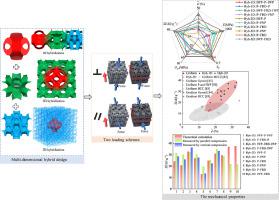当前位置:
X-MOL 学术
›
Int. J. Mech. Sci.
›
论文详情
Our official English website, www.x-mol.net, welcomes your feedback! (Note: you will need to create a separate account there.)
Multi-dimensional hybridized TPMS with high energy absorption capacity
International Journal of Mechanical Sciences ( IF 7.3 ) Pub Date : 2024-03-28 , DOI: 10.1016/j.ijmecsci.2024.109244 Xiaonan Zhang , Shilin Yan , Xiangyu Xie , Yongjing Li , Cheng Wang , Pin Wen
International Journal of Mechanical Sciences ( IF 7.3 ) Pub Date : 2024-03-28 , DOI: 10.1016/j.ijmecsci.2024.109244 Xiaonan Zhang , Shilin Yan , Xiangyu Xie , Yongjing Li , Cheng Wang , Pin Wen

|
Lattice structures based on triply periodic minimal surfaces (TPMSs) have received extensive research attention due to their lightweight, tremendously high ductility, and excellent energy absorption. In this study, the advantages of several types of TPMSs-based lattice structures were integrated by proposing a multi-dimensional hybrid design for the first time. Based on the P, IWP, and FRD structures, one-dimensional (1D), 2D, and 3D hybridizations were successfully achieved by using the Sigmoid function. The technique of powder bed fusion of metal using a laser beam (PBF–LB/M) was utilized to fabricate the designed TPMS structures with Al–Si10–Mg powder. Their mechanical properties under different loading directions were investigated both experimentally and numerically. The results demonstrate that the hybridization strategy effectively modifies the mechanical behaviour of the TPMS structures. When the hybridization direction aligns parallel to the compression direction, the hybrid structure exhibits greater specific energy absorption, while vertical alignment results in a higher Young's modulus. Notably, the 2D hybrid P–FRD structure possesses the most excellent mechanical properties under parallel compression. Moreover, the 1D and 2D hybrid structures exhibit superior specific energy absorption than the uniform structure, with maximum energy absorption of 45.02% and 52.81%, respectively. The proposed hybrid design strategies are expected to accelerate the application of energy-absorbing structures in practical engineering.
中文翻译:

高能量吸收能力的多维混合式TPMS
基于三周期最小表面(TPMS)的晶格结构因其轻质、极高的延展性和出色的能量吸收而受到广泛的研究关注。在这项研究中,首次提出多维混合设计,整合了几种基于TPMS的晶格结构的优点。基于P、IWP和FRD结构,利用Sigmoid函数成功实现了一维(1D)、2D和3D杂交。利用激光束 (PBF-LB/M) 金属粉末床熔融技术,用 Al-Si10-Mg 粉末制造设计的 TPMS 结构。通过实验和数值研究了它们在不同载荷方向下的机械性能。结果表明,混合策略有效地改变了 TPMS 结构的机械行为。当混合方向平行于压缩方向排列时,混合结构表现出更大的比能量吸收,而垂直排列则导致更高的杨氏模量。值得注意的是,二维混合P-FRD结构在平行压缩下具有最优异的机械性能。此外,一维和二维混合结构表现出比均匀结构更优异的比能量吸收,最大能量吸收分别为45.02%和52.81%。所提出的混合设计策略有望加速吸能结构在实际工程中的应用。
更新日期:2024-03-28
中文翻译:

高能量吸收能力的多维混合式TPMS
基于三周期最小表面(TPMS)的晶格结构因其轻质、极高的延展性和出色的能量吸收而受到广泛的研究关注。在这项研究中,首次提出多维混合设计,整合了几种基于TPMS的晶格结构的优点。基于P、IWP和FRD结构,利用Sigmoid函数成功实现了一维(1D)、2D和3D杂交。利用激光束 (PBF-LB/M) 金属粉末床熔融技术,用 Al-Si10-Mg 粉末制造设计的 TPMS 结构。通过实验和数值研究了它们在不同载荷方向下的机械性能。结果表明,混合策略有效地改变了 TPMS 结构的机械行为。当混合方向平行于压缩方向排列时,混合结构表现出更大的比能量吸收,而垂直排列则导致更高的杨氏模量。值得注意的是,二维混合P-FRD结构在平行压缩下具有最优异的机械性能。此外,一维和二维混合结构表现出比均匀结构更优异的比能量吸收,最大能量吸收分别为45.02%和52.81%。所提出的混合设计策略有望加速吸能结构在实际工程中的应用。



























 京公网安备 11010802027423号
京公网安备 11010802027423号